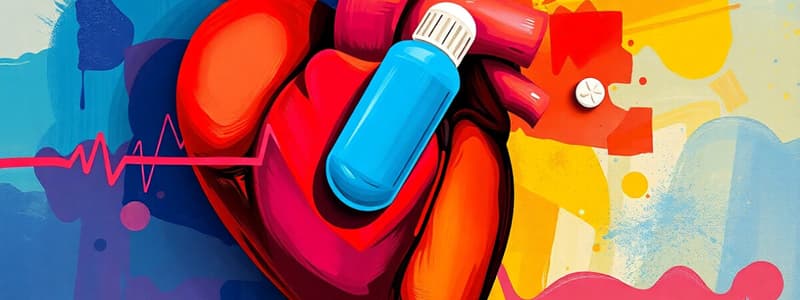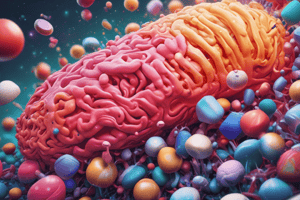Podcast
Questions and Answers
A patient is prescribed quinidine for the treatment of supraventricular dysrhythmia. Which of the following potential effects of quinidine on the heart should the nurse monitor the patient for?
A patient is prescribed quinidine for the treatment of supraventricular dysrhythmia. Which of the following potential effects of quinidine on the heart should the nurse monitor the patient for?
- Slowed impulse conduction. (correct)
- Increased vagal input to the heart.
- Shortened QT interval.
- Decreased QRS complex duration.
A patient is started on lidocaine (Xylocaine) for ventricular dysrhythmias. Which of the following effects on the ECG would be expected?
A patient is started on lidocaine (Xylocaine) for ventricular dysrhythmias. Which of the following effects on the ECG would be expected?
- Lengthened PR interval.
- Widened QRS complex.
- Accelerated repolarization. (correct)
- Prolonged QT interval.
A patient with a history of dysrhythmias is prescribed a Class IC antiarrhythmic drug. What potentially serious adverse effect should the healthcare provider closely monitor for?
A patient with a history of dysrhythmias is prescribed a Class IC antiarrhythmic drug. What potentially serious adverse effect should the healthcare provider closely monitor for?
- Exacerbation of existing dysrhythmias or the development of new ones. (correct)
- Increased AV node conduction.
- Hypotension due to beta-adrenergic blockade.
- Bradycardia.
A patient taking quinidine develops ringing in the ears, blurred vision, and a headache. The patient's labs also indicate they have cardiotoxicity. The nurse recognizes these symptoms as indicative of:
A patient taking quinidine develops ringing in the ears, blurred vision, and a headache. The patient's labs also indicate they have cardiotoxicity. The nurse recognizes these symptoms as indicative of:
A patient is prescribed propranolol for the treatment of dysrhythmias. Propranolol is in which class of anti-dysrhythmic drugs?
A patient is prescribed propranolol for the treatment of dysrhythmias. Propranolol is in which class of anti-dysrhythmic drugs?
A patient's ECG shows a prolonged QT interval. Which class of antidysrhythmic drugs should be administered with extreme caution due to the risk of Torsades de pointes?
A patient's ECG shows a prolonged QT interval. Which class of antidysrhythmic drugs should be administered with extreme caution due to the risk of Torsades de pointes?
A patient is diagnosed with a bradydysrhythmia. Which area of the heart is MOST likely to be affected, causing this condition?
A patient is diagnosed with a bradydysrhythmia. Which area of the heart is MOST likely to be affected, causing this condition?
A patient with a history of sustained supraventricular tachycardia (SVT) is prescribed an antidysrhythmic drug. The medication works by slowing conduction through the AV node. Which drug is MOST likely prescribed?
A patient with a history of sustained supraventricular tachycardia (SVT) is prescribed an antidysrhythmic drug. The medication works by slowing conduction through the AV node. Which drug is MOST likely prescribed?
A patient is experiencing atrial fibrillation. The ECG reading would NOT show which of the following?
A patient is experiencing atrial fibrillation. The ECG reading would NOT show which of the following?
Which of the following best describes the mechanism of action of Class I antidysrhythmic drugs?
Which of the following best describes the mechanism of action of Class I antidysrhythmic drugs?
A patient is prescribed digoxin for heart failure and subsequently develops ventricular premature beats. Which electrolyte imbalance is MOST likely contributing to this digoxin-induced dysrhythmia?
A patient is prescribed digoxin for heart failure and subsequently develops ventricular premature beats. Which electrolyte imbalance is MOST likely contributing to this digoxin-induced dysrhythmia?
Which ECG component represents ventricular repolarization?
Which ECG component represents ventricular repolarization?
A patient is diagnosed with a re-entry arrhythmia. Which mechanism is primarily responsible for this type of dysrhythmia?
A patient is diagnosed with a re-entry arrhythmia. Which mechanism is primarily responsible for this type of dysrhythmia?
Which of the following effects of propranolol contributes to its therapeutic use in treating dysrhythmias caused by excessive sympathetic stimulation?
Which of the following effects of propranolol contributes to its therapeutic use in treating dysrhythmias caused by excessive sympathetic stimulation?
A patient with recurrent ventricular fibrillation is prescribed amiodarone. What electrophysiological effect of amiodarone is most directly related to its therapeutic action in this scenario?
A patient with recurrent ventricular fibrillation is prescribed amiodarone. What electrophysiological effect of amiodarone is most directly related to its therapeutic action in this scenario?
A patient taking amiodarone begins experiencing excessive slowing of heart rate. Which concurrent medication is most likely contributing to this adverse effect?
A patient taking amiodarone begins experiencing excessive slowing of heart rate. Which concurrent medication is most likely contributing to this adverse effect?
Verapamil is prescribed to a patient with atrial fibrillation. The primary goal of this medication in this situation is to:
Verapamil is prescribed to a patient with atrial fibrillation. The primary goal of this medication in this situation is to:
A patient on digoxin develops hypokalemia. Which of the following is the most significant risk associated with this electrolyte imbalance in the context of digoxin therapy?
A patient on digoxin develops hypokalemia. Which of the following is the most significant risk associated with this electrolyte imbalance in the context of digoxin therapy?
A patient with a history of asthma is prescribed an antiarrhythmic drug. Which of the following medications should be avoided, if possible, due to its potential to exacerbate the patient's respiratory condition?
A patient with a history of asthma is prescribed an antiarrhythmic drug. Which of the following medications should be avoided, if possible, due to its potential to exacerbate the patient's respiratory condition?
Which antidysrhythmic drug is also commonly used in the treatment of heart failure?
Which antidysrhythmic drug is also commonly used in the treatment of heart failure?
Which of the following is a common adverse effect associated with verapamil and diltiazem?
Which of the following is a common adverse effect associated with verapamil and diltiazem?
A patient is prescribed amiodarone and simvastatin concurrently. What potential drug interaction should the prescriber be most concerned about?
A patient is prescribed amiodarone and simvastatin concurrently. What potential drug interaction should the prescriber be most concerned about?
Sotalol shares mechanism of action with which class of antiarrhythmic drugs?
Sotalol shares mechanism of action with which class of antiarrhythmic drugs?
Which of the following is the primary mechanism of action of Class IA antiarrhythmic drugs like quinidine?
Which of the following is the primary mechanism of action of Class IA antiarrhythmic drugs like quinidine?
Which electrocardiogram (ECG) change is MOST likely to be observed in a patient taking a Class IA antiarrhythmic drug?
Which electrocardiogram (ECG) change is MOST likely to be observed in a patient taking a Class IA antiarrhythmic drug?
A patient receiving lidocaine for ventricular dysrhythmias begins to exhibit confusion and paresthesias. Which of the following is the MOST likely explanation for these adverse effects?
A patient receiving lidocaine for ventricular dysrhythmias begins to exhibit confusion and paresthesias. Which of the following is the MOST likely explanation for these adverse effects?
Why are Class IC antiarrhythmic drugs generally reserved for use in patients with otherwise structurally normal hearts and limited dysrhythmias?
Why are Class IC antiarrhythmic drugs generally reserved for use in patients with otherwise structurally normal hearts and limited dysrhythmias?
A patient is prescribed a beta-blocker for the management of a supraventricular tachyarrhythmia originating from increased sympathetic drive. Given the limited selection of beta-blockers specifically approved for dysrhythmias, and considering the need for rapid control during an acute episode, which of the following would be the MOST appropriate initial choice?
A patient is prescribed a beta-blocker for the management of a supraventricular tachyarrhythmia originating from increased sympathetic drive. Given the limited selection of beta-blockers specifically approved for dysrhythmias, and considering the need for rapid control during an acute episode, which of the following would be the MOST appropriate initial choice?
Which electrophysiological effect is associated with amiodarone?
Which electrophysiological effect is associated with amiodarone?
A patient with recurrent ventricular fibrillation is prescribed amiodarone. What is the primary therapeutic action of amiodarone in this scenario?
A patient with recurrent ventricular fibrillation is prescribed amiodarone. What is the primary therapeutic action of amiodarone in this scenario?
Verapamil and diltiazem are effective in treating which type of supraventricular tachycardia (SVT)?
Verapamil and diltiazem are effective in treating which type of supraventricular tachycardia (SVT)?
Which adverse effect is most closely associated with amiodarone's long half-life?
Which adverse effect is most closely associated with amiodarone's long half-life?
Which concurrent medication increases the risk of excessive slowing of heart rate when taken with amiodarone?
Which concurrent medication increases the risk of excessive slowing of heart rate when taken with amiodarone?
Which electrolyte imbalance potentiates digoxin toxicity, increasing the risk of cardiotoxicity?
Which electrolyte imbalance potentiates digoxin toxicity, increasing the risk of cardiotoxicity?
A patient is prescribed digoxin for heart failure and subsequently develops visual disturbances and gastrointestinal upset. Which of the following is the most likely cause?
A patient is prescribed digoxin for heart failure and subsequently develops visual disturbances and gastrointestinal upset. Which of the following is the most likely cause?
What is the primary mechanism by which digoxin suppresses supraventricular dysrhythmias?
What is the primary mechanism by which digoxin suppresses supraventricular dysrhythmias?
A patient with heart failure and atrial fibrillation is prescribed digoxin. Besides slowing the ventricular rate, what other potential benefit does digoxin offer in this case?
A patient with heart failure and atrial fibrillation is prescribed digoxin. Besides slowing the ventricular rate, what other potential benefit does digoxin offer in this case?
A patient with a history of asthma is prescribed an antiarrhythmic drug. Which of the following beta-blockers should be avoided, if possible, due to its non-selective beta-adrenergic blocking properties?
A patient with a history of asthma is prescribed an antiarrhythmic drug. Which of the following beta-blockers should be avoided, if possible, due to its non-selective beta-adrenergic blocking properties?
Which of the following best describes the primary mechanism by which Class IV antidysrhythmic drugs exert their effects on cardiac tissue?
Which of the following best describes the primary mechanism by which Class IV antidysrhythmic drugs exert their effects on cardiac tissue?
A patient develops a dysrhythmia characterized by rapid, chaotic atrial activity. Which Vaughn Williams classification of antidysrhythmic drug would least be appropriate for rate control?
A patient develops a dysrhythmia characterized by rapid, chaotic atrial activity. Which Vaughn Williams classification of antidysrhythmic drug would least be appropriate for rate control?
Which of the following is a potential consequence of a drug-induced disturbance in automaticity within the heart?
Which of the following is a potential consequence of a drug-induced disturbance in automaticity within the heart?
A patient is experiencing re-entry arrhythmia. Which of the following is the most likely underlying mechanism?
A patient is experiencing re-entry arrhythmia. Which of the following is the most likely underlying mechanism?
Which of the following scenarios presents the greatest risk associated with antidysrhythmic drug therapy?
Which of the following scenarios presents the greatest risk associated with antidysrhythmic drug therapy?
A patient with a history of asthma is prescribed an antidysrhythmic drug. Which of the following medications has the LEAST impact on a patient's respiratory condition?
A patient with a history of asthma is prescribed an antidysrhythmic drug. Which of the following medications has the LEAST impact on a patient's respiratory condition?
A patient is prescribed a medication that selectively blocks $I_{Kr}$ channels in cardiac myocytes. What effect would you expect this medication to have on the action potential?
A patient is prescribed a medication that selectively blocks $I_{Kr}$ channels in cardiac myocytes. What effect would you expect this medication to have on the action potential?
A researcher is investigating a novel compound that prolongs the effective refractory period (ERP) in ventricular myocytes without significantly affecting the QT interval. Which ionic current is MOST likely targeted by this compound?
A researcher is investigating a novel compound that prolongs the effective refractory period (ERP) in ventricular myocytes without significantly affecting the QT interval. Which ionic current is MOST likely targeted by this compound?
Flashcards
Class IA Agents
Class IA Agents
Block sodium channels, slowing impulse conduction and delaying repolarization in the heart.
Class IB Agents
Class IB Agents
Blocks cardiac sodium channels, slows conduction, reduces automaticity, and accelerates repolarization in the ventricles.
Class IC Agents
Class IC Agents
Block cardiac sodium channels and delay ventricular repolarization, but can exacerbate existing dysrhythmias.
Quinidine
Quinidine
Signup and view all the flashcards
Lidocaine
Lidocaine
Signup and view all the flashcards
Propranolol (Inderal)
Propranolol (Inderal)
Signup and view all the flashcards
Propranolol's Cardiac Effects
Propranolol's Cardiac Effects
Signup and view all the flashcards
Propranolol Therapeutic Use
Propranolol Therapeutic Use
Signup and view all the flashcards
Amiodarone Therapeutic Use
Amiodarone Therapeutic Use
Signup and view all the flashcards
Amiodarone's Effects on ECG
Amiodarone's Effects on ECG
Signup and view all the flashcards
Amiodarone Drug Interactions
Amiodarone Drug Interactions
Signup and view all the flashcards
Amiodarone Adverse Effects
Amiodarone Adverse Effects
Signup and view all the flashcards
Verapamil/Diltiazem Effects
Verapamil/Diltiazem Effects
Signup and view all the flashcards
Verapamil/Diltiazem Uses
Verapamil/Diltiazem Uses
Signup and view all the flashcards
Verapamil/Diltiazem Adverse Effects
Verapamil/Diltiazem Adverse Effects
Signup and view all the flashcards
Dysrhythmia
Dysrhythmia
Signup and view all the flashcards
SA Node
SA Node
Signup and view all the flashcards
AV Node
AV Node
Signup and view all the flashcards
P Wave
P Wave
Signup and view all the flashcards
QRS Complex
QRS Complex
Signup and view all the flashcards
T Wave
T Wave
Signup and view all the flashcards
Causes of Dysrhythmias
Causes of Dysrhythmias
Signup and view all the flashcards
Supraventricular Dysrhythmias
Supraventricular Dysrhythmias
Signup and view all the flashcards
Quinidine's Cardiac Effects
Quinidine's Cardiac Effects
Signup and view all the flashcards
Major Quinidine Adverse Effects
Major Quinidine Adverse Effects
Signup and view all the flashcards
Quinidine-Digoxin Interaction
Quinidine-Digoxin Interaction
Signup and view all the flashcards
Lidocaine's Main Adverse Effects
Lidocaine's Main Adverse Effects
Signup and view all the flashcards
Risk with Class IC Agents
Risk with Class IC Agents
Signup and view all the flashcards
Tachydysrhythmias
Tachydysrhythmias
Signup and view all the flashcards
Bradydysrhythmias
Bradydysrhythmias
Signup and view all the flashcards
Electrocardiogram (ECG)
Electrocardiogram (ECG)
Signup and view all the flashcards
Atrioventricular Block
Atrioventricular Block
Signup and view all the flashcards
Reentry (recirculating activation)
Reentry (recirculating activation)
Signup and view all the flashcards
Class I Antidysrhythmics
Class I Antidysrhythmics
Signup and view all the flashcards
Class II Antidysrhythmics
Class II Antidysrhythmics
Signup and view all the flashcards
Class III Antidysrhythmics
Class III Antidysrhythmics
Signup and view all the flashcards
Propranolol Class
Propranolol Class
Signup and view all the flashcards
Propranolol Adverse Cardiac Effects
Propranolol Adverse Cardiac Effects
Signup and view all the flashcards
Digoxin's Action on Dysrhythmias
Digoxin's Action on Dysrhythmias
Signup and view all the flashcards
Class III Mechanisms
Class III Mechanisms
Signup and view all the flashcards
Amiodarone's Notorious Adverse Effects
Amiodarone's Notorious Adverse Effects
Signup and view all the flashcards
Diuretics and Antiarrhythmics Risk
Diuretics and Antiarrhythmics Risk
Signup and view all the flashcards
Amiodarone + Beta Blocker Risk
Amiodarone + Beta Blocker Risk
Signup and view all the flashcards
Verapamil & Diltiazem: Uses
Verapamil & Diltiazem: Uses
Signup and view all the flashcards
Digoxin's Action on AV/SA Nodes
Digoxin's Action on AV/SA Nodes
Signup and view all the flashcards
Digoxin's Main Adverse Effect
Digoxin's Main Adverse Effect
Signup and view all the flashcards
Study Notes
- Cardiovascular medications part II include drugs to treat dysrhythmias
Dysrhythmia
- Dysrhythmia refers to an abnormality in the rhythm of the heartbeat, also known as arrhythmia
- Occurs due to disturbances in impulse formation
- Tachydysrhythmias include supraventricular tachycardia (SVT) and ventricular arrhythmias
- Bradydysrhythmias include slow heart rates
- Virtually all drugs that treat dysrhythmias can also cause dysrhythmias
Electrical Properties of the Heart
- Impulse conduction involves specific pathways and timing
- The sinoatrial (SA) node serves as the heart's natural pacemaker
- The atrioventricular (AV) node is a critical node in the electrical pathway
- The His-Purkinje system provides a network for rapid impulse conduction
The Electrocardiogram
- An electrocardiogram (ECG) graphically represents the heart's electrical activity
- Key ECG waves include P wave, QRS complex, and T wave
- The P wave corresponds to atrial depolarization
- The QRS complex represents ventricular depolarization
- The T wave reflects ventricular repolarization
- Other ECG components are the PR interval, QT interval, and ST segment
Generation of Dysrhythmias
- Two primary causes: disturbances of automaticity and disturbances of conduction
- Disturbances of conduction can involve atrioventricular (AV) block
- Reentry, or recirculating activation, is another cause of conduction disturbances
Classification of Antidysrhythmic Drugs
- The Vaughan Williams classification categorizes antidysrhythmic drugs
- Class I drugs are sodium channel blockers
- Class II drugs are beta blockers
- Class III drugs are potassium channel blockers
- Class IV drugs are calcium channel blockers
- Other antidysrhythmic drugs include adenosine, digoxin, and ibutilide
Common Dysrhythmias and Their Treatment
-
Supraventricular dysrhythmias originate above the ventricles
-
Atrial fibrillation, atrial flutter, and sustained supraventricular tachycardia (SVT) are examples of supraventricular dysrhythmias
-
Sustained ventricular tachycardia, ventricular fibrillation, and ventricular premature beats are ventricular dysrhythmias
-
Digoxin-induced ventricular dysrhythmias and torsades de pointes are types of ventricular dysrhythmias
-
Principles of antidysrhythmic drug therapy involve balancing risks and benefits
-
Important factors in balancing risks and benefits are assessing dysrhythmia properties (sustained vs. nonsustained, asymptomatic vs. symptomatic, and supraventricular vs. ventricular)
-
Acute and long-term treatment phases must be considered for therapy
-
Minimizing risk is a key principle when selecting antidysrhythmic drugs
Class I: Sodium Channel Blockers
- Sodium Channel Blockers comprise Class IA agents
- Class IB agents also fall under Sodium Channel Blockers
- And Class IC agents are also considered sodium channel blockers
Class IA Agents
- Quinidine can be used as an example
- Quinidine affects the heart by blocking sodium channels, slowing impulse conduction, delaying repolarization, and blocking vagal input
- Quinidine has effects on ECG: widens the QRS complex and prolongs the QT interval
- Quinidine is used against supraventricular and ventricular dysrhythmias
- Adverse effects of Quinidine include diarrhea, cinchonism (quinidine overdose), cardiotoxicity, arterial embolism, alpha-adrenergic blockade-resulting in hypotension, and hypersensitivity reactions
- Drug interactions of Quinidine include Digoxin
Class IB Agents
- Lidocaine (Xylocaine) is an example
- Lidocaine affects the heart and ECG: blocks cardiac sodium channels, slowing conduction in the atria, ventricles, and His-Purkinje system.
- Reduces automaticity in the ventricles and His-Purkinje system and accelerates repolarization.
- Adverse effects include CNS effects, drowsiness, confusion, and paresthesias
Class IC Agents
- Class IC agents function by blocking cardiac sodium channels and delaying ventricular repolarization
- All class IC agents carry the risk of exacerbating existing dysrhythmias and creating new ones
- Flecainide and Propafenone are two of the class IC agents
Class II: Beta Blockers
-
Beta-adrenergic blocking agents are Class II Beta Blockers
-
Four beta blockers approved for treating dysrhythmias are propranolol, acebutolol, esmolol, and sotalol
-
Propranolol (Inderal) is a nonselective beta-adrenergic antagonist
-
Propranolol affects the heart and ECG: decreases SA nodal automaticity, slows conduction through the AV node, and reduces myocardial contractility
-
Therapeutic uses of propranolol include dysrhythmias caused by excessive sympathetic stimulation and supraventricular tachydysrhythmias
-
Propranolol's effects include suppression of excessive discharge and slowing of ventricular rate
-
Adverse effects of propranolol encompass heart block, heart failure, AV block, sinus arrest, hypotension, and bronchospasm (in asthma patients)
-
Acebutolol (Sectral) and Esmolol (Brevibloc) are other class II: beta blockers
Class III: Potassium Channel Blockers
- Amiodarone (Cordarone, Pacerone) is a Class III Potassium Channel Blocker
- Amiodarone is therapeutically indicated for recurrent ventricular fibrillation and recurrent hemodynamically unstable ventricular tachycardia.
- Amiodarone affects the heart and ECG by causing QRS widening, prolonging PR and QT intervals, reducing SA nodal automaticity, reducing contractility, and slowing conduction velocity
- Amiodarone drug interactions include Quinidine, Cyclosporine, Digoxin, Procainamide, Diltiazem, Phenytoin, Warfarin, Lovastatin, simvastatin and atorvastatin
- Adverse effects of Amiodarone include protracted half-life, pulmonary toxicity, cardiotoxicity, toxicity in pregnancy and breast-feeding, corneal microdeposits, and optic neuropathy
- Diuretics and drugs that prolong the QT interval increase the risk of severe dysrhythmias with Class III Potassium Channel Blockers
- Combining amiodarone with a beta blocker, verapamil, or diltiazem can lead to excessive slowing of heart rate
Class IV: Calcium Channel Blockers
- Verapamil (Calan, Isoptin, Verelan) and diltiazem (Cardizem) are examples of Class IV Calcium Channel Blockers
- These medications reduce SA nodal automaticity, delay AV nodal conduction, and reduce myocardial contractility
- Verapamil and Diltiazem are used for slow ventricular rate for (atrial fibrillation or atrial flutter) and terminate SVT caused by an AV nodal reentrant circuit
- Adverse effects from Class IV: Bradycardia, Hypotension, AV block, Heart failure, Peripheral edema, Constipation
- Verapamil and diltiazem can elevate digoxin levels
- There is an increased risk when combined with a beta blocker
Other Antidysrhythmic Drugs
- Digoxin (Lanoxin) is for heart failure
- Also used to treat supraventricular dysrhythmias, while being inactive against ventricular dysrhythmias
- Digoxin decreases conduction through the AV node and suppresses automaticity in the SA node
- Digoxin can shorten a QT interval
- Cardiotoxicity is an adverse effect of Digoxin
- Hypokalemia increases the risk of cardiotoxicity with digoxin
Studying That Suits You
Use AI to generate personalized quizzes and flashcards to suit your learning preferences.




